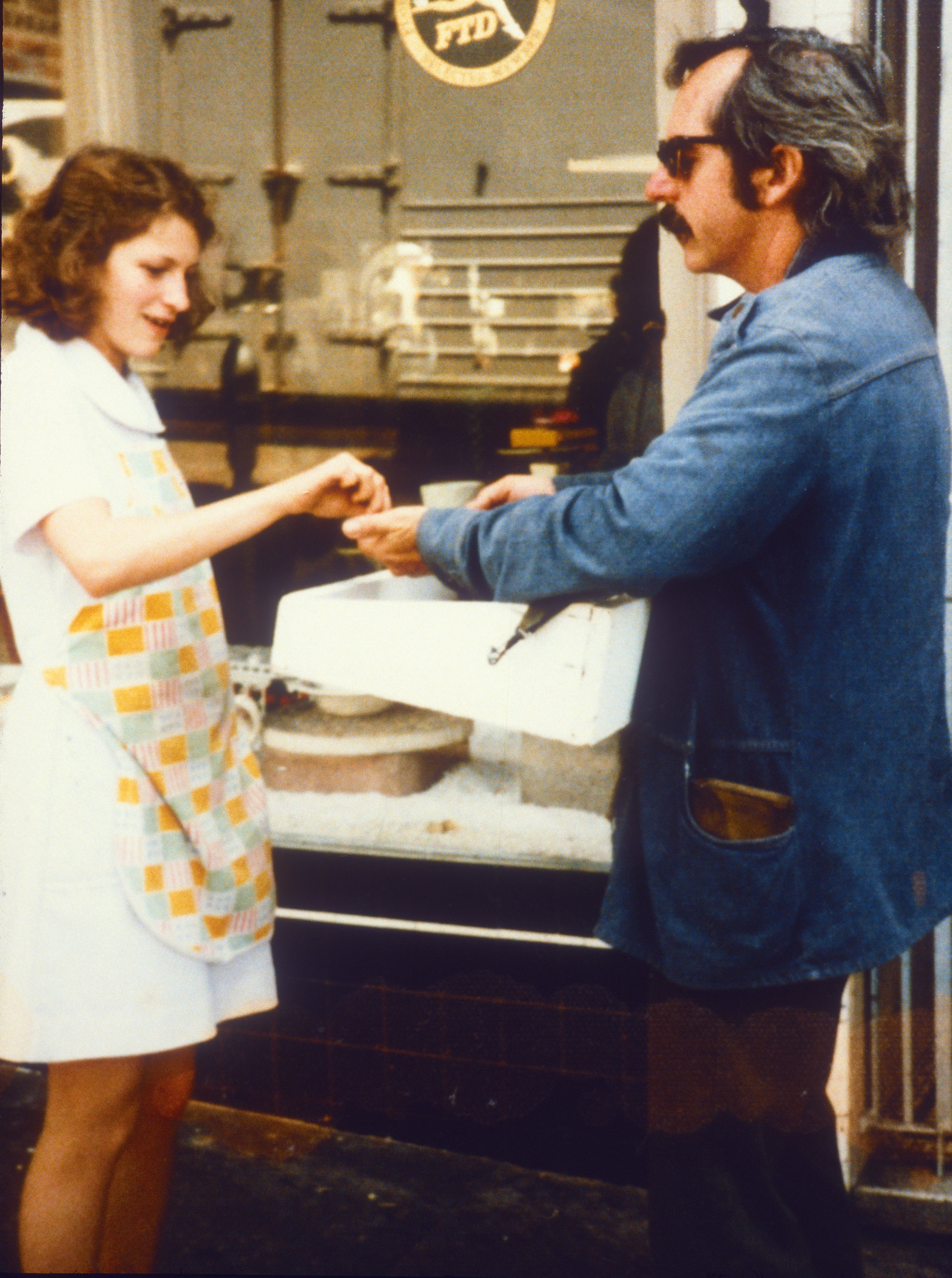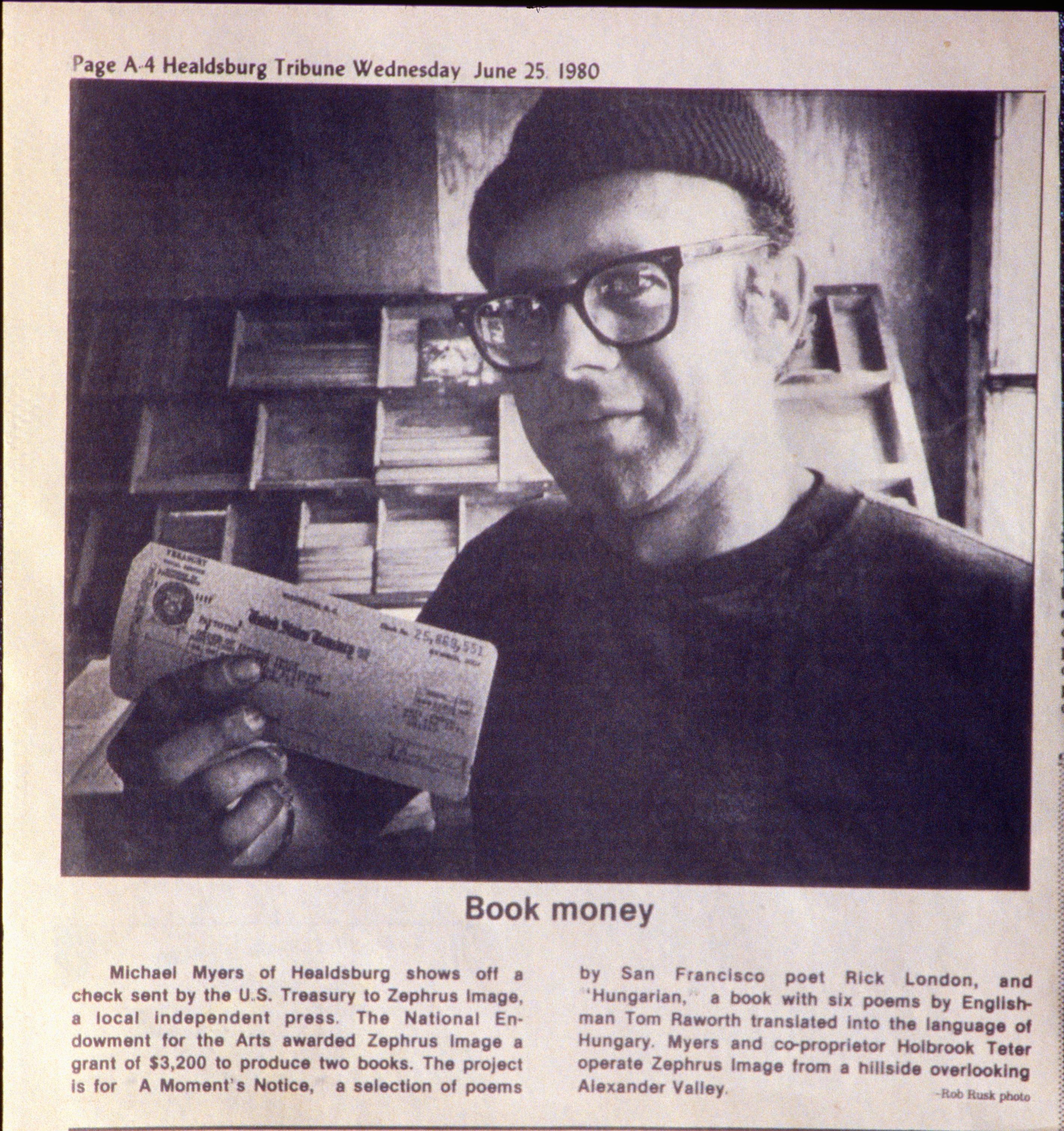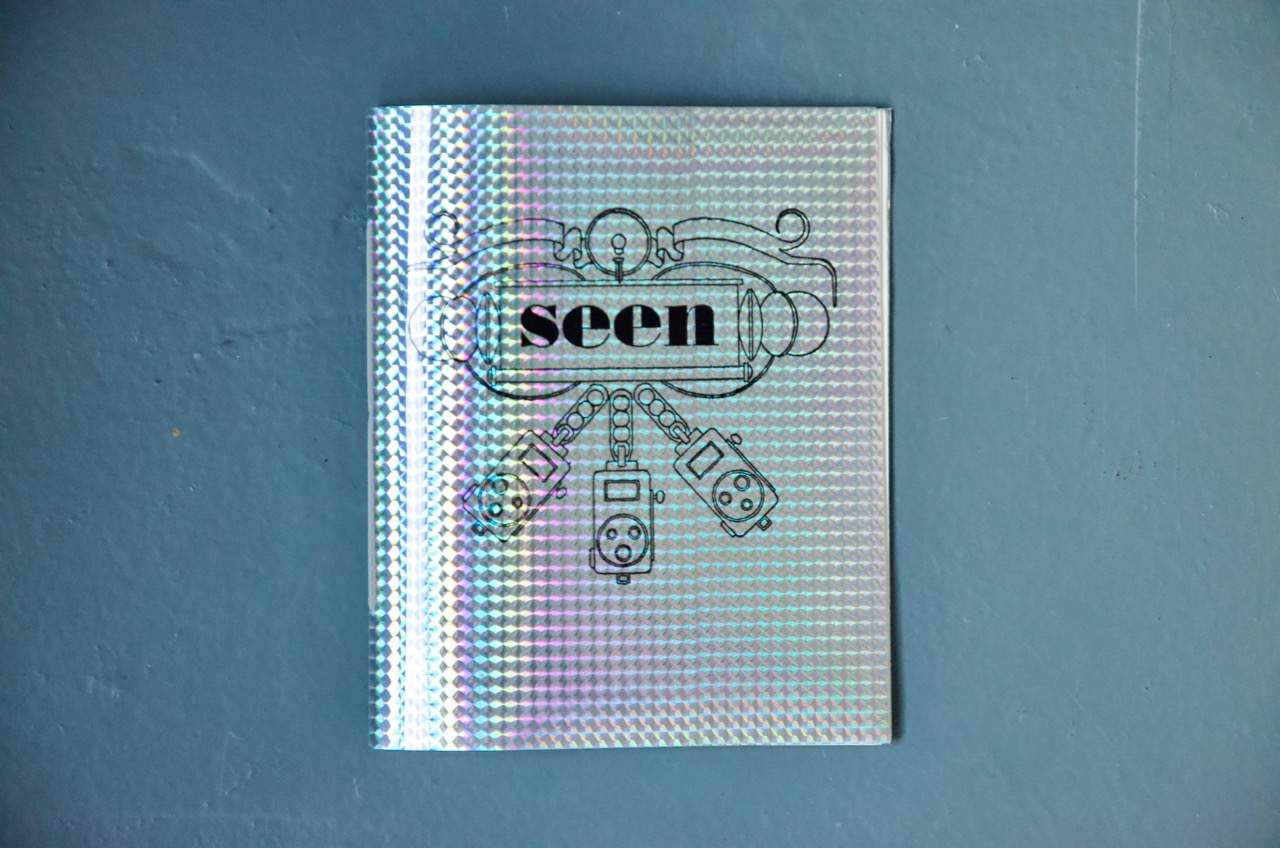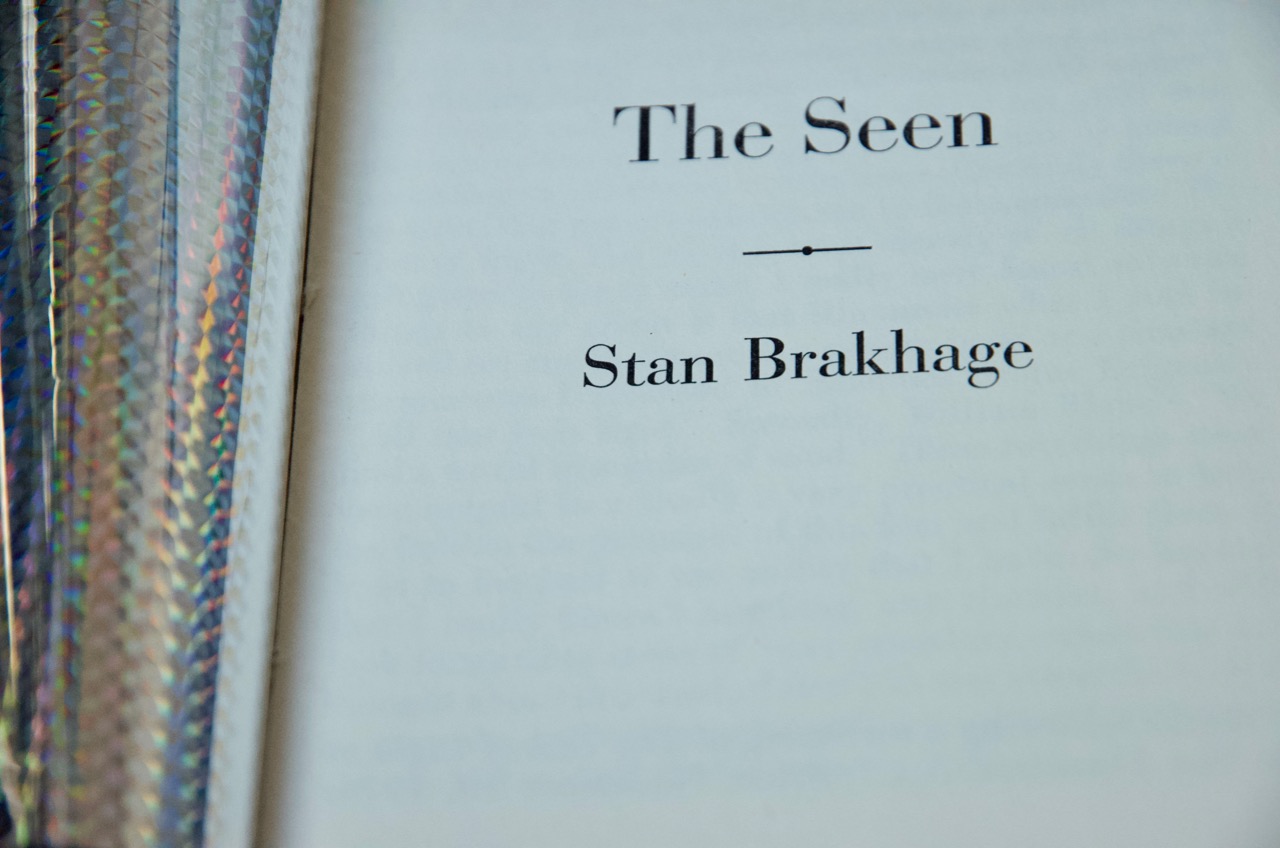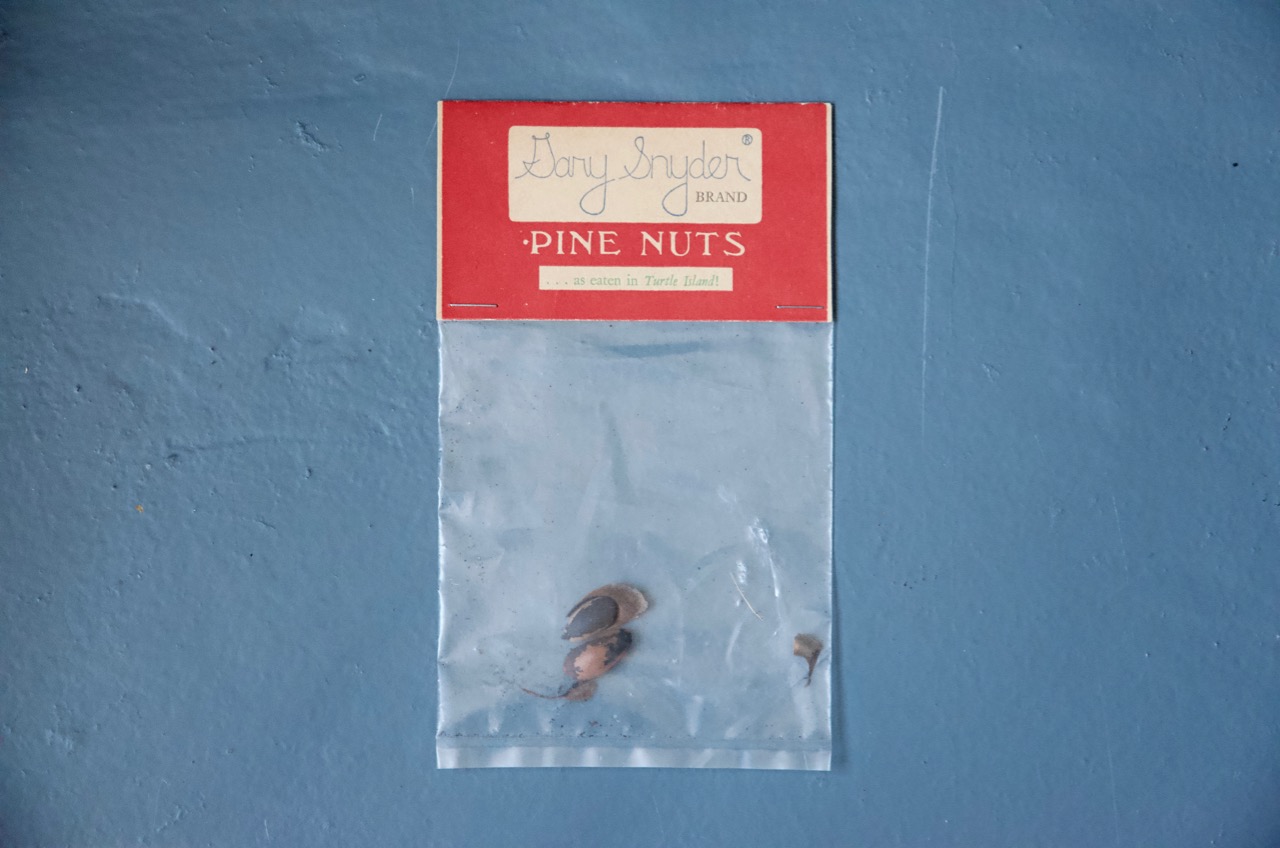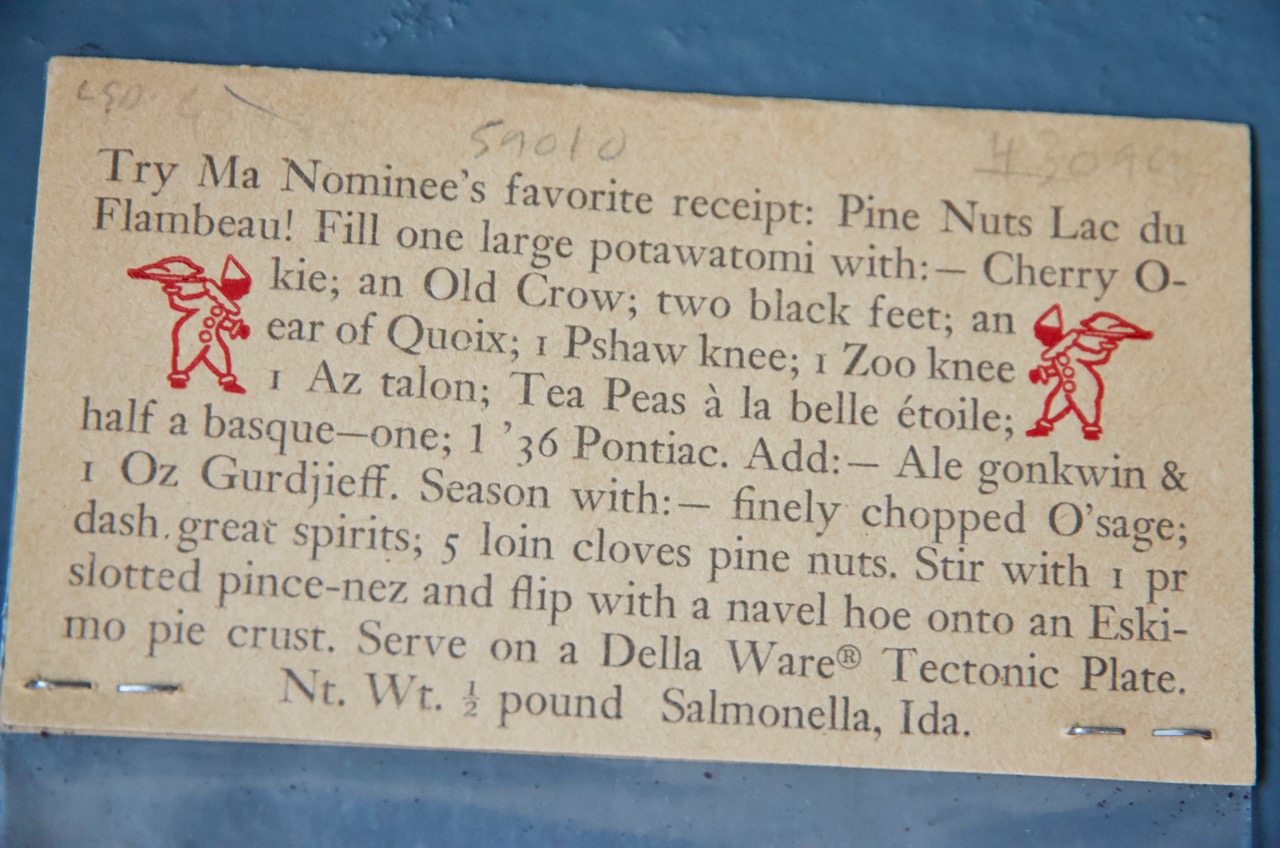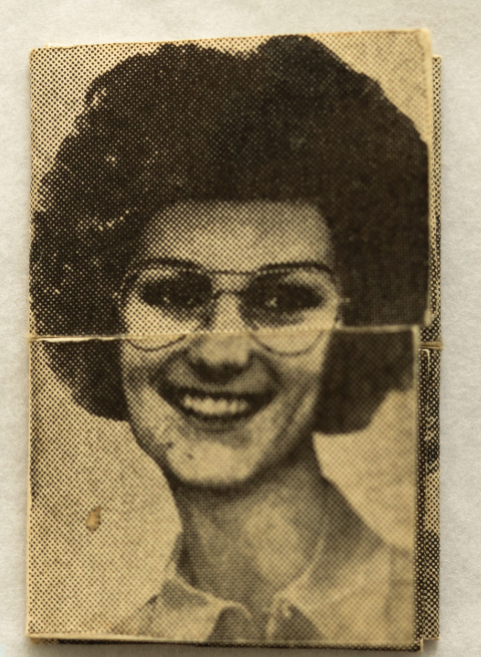Zephyrus Image:
A Showering Rainbow
—Carl R. Williams
A Showering Rainbow
At first, The Seen was bound in so-called two-stage wrappers, composed of two sheets of reflective, patterned mylar, with a strange sort of steampunk-device motif in fine black linocut on the upper wrapper, sewn on to a block of nice paper. This, in turn, was dropped into an orange paper envelope with a ‘found’ photographic tintype or zinc cut of a projector. This first version is wildly rare now – I think I’ve only had it three times, once from an avant-garde filmmaker, the second was from the publishers’ archive and the third was a signed and inscribed presentation copy from Brakhage to Black Mountain School poet Robert Creeley and his wife Jess. The copy illustrated herein, is a scarce variant or second edition, take your pick of terms, with only one mylar wrapper, but it still showers like a rainbow-like you would expect when it is moved around. The publication is impossible to photograph clearly as the patterned silver paper prismatically refracts and splits into colours, like the sun through rain.
Zephyrus Image, the fine small press that designed and printed The Seen, was formed by a partnership between activist Teter and the artist Michael Myers, who started the press in The Bay Area in the early 1970s. Zephyrus Image was indebted to DaDa but with the exacting standards of a snooty private press of an earlier epoch. Teter and Myers loved printing words and images and combining them to create troublesome paper pranks to provoke people and throw light on obscure ideas and political and ecological iniquities, but also to elevate sublime and enigmatic poetry. Teter personified ‘word’; he was an ultra-educated scholar with a string of higher degrees and knowledge of a handful of very different languages, in which he was fluent, and who had a penchant for typography. Myers, the drunken, drugged up, skateboarding punk, represented ‘image’; he was a hyper-intuitive and disciplined draughtsmen, able to create a faery world from spark plugs and a faery feller from a longhaired hippy. Together they were The Zephyrus Image, ‘Zephyrous Image’ or their ‘pro bono’ arm known as the ‘Hermes Free Press’.
A lot of the New Wave subculture that was soon to emerge took inspiration from their activities. The duo shared Brakhage’s innocent acts of gift-giving and disregard for making money from their creative output. As Zephyrus Image, they made elaborate, labour intensive satires and bad puns on paper that were often made to look cheap and throwaway and were usually handed out using guerilla actions on the streets of San Francisco or sent through the mail to surprised recipients. One example of this was a flyer for a talk at the Special Collection Department of San Francisco Public Library with a coffee stain that was, of course, not a stain but a beautiful sepia linocut by Myers (worthy of Ed Ruscha but produced completely independently of him).
Zephyrus Image reserved a special place in small press hell for Richard Nixon with a print trolling campaign that included bumper stickers in rebus (IMPEACH NIXON) and a print entitled Humiliation – a sort of pastiche White House menu denouncing the Cambodian incursion with an atomic bomb vignette at the head of the page. They also produced a ‘Dick and Pat Fly Swatter’ with Mark Motheresbaugh of DEVO.
However, their stoned humour wasn’t just reserved for ‘Grand Ole Party’ Republicans – they also lampooned the great and the good from within the ‘movement’ too. For instance, one of their masterworks from 1975 is their Gary Snyder Brand ® . Pine Nuts …as eaten in Turtle Island. Try Ma Nominee`s favorite receipt: Pine Nuts Lac du Flambeau!, a spoof bag of eating nuts with a label bearing a facsimile trademark and the signature of the Beat poet Gary Snyder. Stapled to the printed header is a clear bag containing broken nuts, and in some examples, even bits of odds and ends.
This is a very fragile ephemeron that is very rare indeed and you will only find it in a discerning collection. The illustrated copy came from Teter’s archive and was once sold by me to the LSD Library in Geneva. It is an ingenious satire directed at Snyder, a great Beat poet and at the time an eminent literary voice for ecological consciousness and Western Buddhism. Snyder won a Pulitzer Prize in 1975 for his collection of poems entitled Turtle Island, which takes its title from the Native American name for the U.S.A. The book is packed with campfire philosophy and wilderness lore. In Alastair Johnson’s bibliography of Zephyrus Image, he describes how the “staunch anti-Hippies” of the “Zephyrus Image crew derided his marketing of zen consciousness”, the design of Snyder’s books and the “back-to-nature poetry and affectation of Native American ways”.
Myers took great pains to reproduce the trademark calligraphic signature in a sort of Lloyd Reynolds, Reed College Graduate style (Snyder’s alma mater was Reed). These packets were largely distributed via guerrilla actions, mixing them in with other bags of nuts in convenience stores along Geary Boulevard, San Francisco, stickered up at 25 cents apiece. Few packets survived beyond the point-of-sale as the purchaser would almost inevitably discard them – Johnston notes that some of the bags even contained fragments of peyote and “two six-point em quads” which are not very toothsome.
In 1972, The Zephyrus Image published a broadside declaring ‘Hides Ugly Blemishes Embarrassing Spots Vanish – Won`t Fade, Peel or Crack Send 1$ to Acme Beauty Aids’ with a linocut cartoon by Myers’ depicting ‘before’ and ‘after’ scenes of a junkie’s arm in the style of an acne cream advert. ‘Liberate Berkeley’ is another broadside with a very fine linocut that was issued in 1970, depicting a revolutionary-like clenched fist with sinews connected to the dynamite sticks of an elegant time bomb, with rocks scattered at the base, primed Molotov cocktails either side and two submachine guns (with unfolded stocks) framing the tableau. Teter said of this work: “That was the time when Berkeley was liberating the world so we thought we’d work on Berkeley too” (Teter in Johnston, Poltroon Press, 2003).
The rarest and most sought after publication produced by Zephyrus Image is undoubtedly “Hours of fun!”, printed in 1974 and composed of two folded and cut sheets of off-white stiff paper printed with loaned Identi-i-kit portraits of Patty Hearst, tipped in and glued together. Issued by their Hermes Free Press arm, the publication was made possible by a grant from the National Endowment for the Arts. There are only two copies that I know of, one now in Turkey and the other in Harvard’s Houghton Library, both facilitated and put there by me. The late Peter Howard, who was the vendor of Teter’s archive, where both items originally came from, described the publication to me in an email as having the “likeness of a matchbook” that when completed would have had a “striker strip of a matchbook stapled at the bottom”.
The Patty Hearst Ident-i-kit is made up of a series of artist’s impressions of the heiress as she might have looked after being kidnapped by the Symbionese Liberation Army and subsequent ‘defection’. Following the brainwashing and Stockholm syndrome after-effects she endured from the SLA, Hearst reemerged as a clandestine urban guerrilla named ‘Tania’ who wore a succession of disguises and robbed banks, and who wore a very chic beret and toted a machine-gun to pose in front of the SLA flag. The original mock-ups were published in The San Francisco Chronicle, which was part of her father’s vast news empire – her father, of course, being press baron William Randolph Hearst who was one of the historical sources for Orson Welles’ seminal film Citizen Kane (1941).
“Hours of fun!” is cleverly arranged so that permutations of Patty Hearst’s various disguises can be created by folding and unfolding the flaps of the pages. Many of the visual puns created by the Zephyrus Image emerged from drink and drug use and abuse. There’s an account of the poet Tom Raworth describing the publication as essentially coming about as the result of a series of “What if? conversations with Michael after a liquid lunch” after which “the team sprang into action, turning the book out overnight”. It tickled Raworth that Hermes Free Press received a $400 government grant to produce this strange miniature book.
Another small but potent production by Zephyrus Image is ‘Genuine Mormon’, produced in 1977 – a rather dowdy sticker with text and a dotted line printed in black on glossy white paper on a ‘Crack-n Peel’ sticker base. It was calculated to cock a snook at the Mormon obsession with lineage. Former Utah resident and friend of Zephyrus Image, Kristin Haage, spoke to Johnston about the item, explaining that “[Myers] had several other things… all this guerrilla stuff. We went round to all the Mormon sites – the temple, the genealogical society. They had these tables full of brochures and we added.. to the piles of ephemera you could give away”. It is hard to imagine the effect these stickers had on Mormons who came upon them when they were in the very act of seeking their ancestors to incorporate them into their faith.
The most recognised of all their works is surely ‘Help Your Local Junkie Kick’, a fly poster with an incredible linocut illustration in green on newsprint, produced in 1970. In the bibliography included in Johnston’s biography of Zephyrus Image, the original printing block is illustrated, as well as also being used as the illustration on the dust jacket in the form of a photograph posted on a telegraph pole. The titles are written in a weird ‘growing’ tendril font that is echoed by the finely executed and detailed, phantasmagoric illustration below of two mirrored feminine long-haired flower people with their foreheads in their hands and stunted, vestigial wings. They are plugged into a bizarre double hypodermic syringe with a large pendulous drop or pearl suspended amidst a network of angular and very elegant tendrils.
Characteristically, an immense amount of work was put into producing this fly poster, which is artisanal beyond all definitions and yet Myers and Teter merely posted it in the city dump. I also discern an unacknowledged graphical, stylistic and ideological influence upon Matthew Barney’s huge imaginary worlds. In some ways, I think Zephyrus Image was far too good and came from the wrong side of the tracks to ever receive the recognition it deserved. The imagery is resolutely psychedelic but far too misanthropic to have ever been taken up with the same interest as say, the graphic poster work of the so-called Big Five poster artists of the Bay Area Renaissance. Although Myers did make at least one rock poster for a minor group, he was really shooting at obscurity and authenticity and his work would never be useful as a way of drumming up a large audience. Zephyrus Image is finding an audience now though, through the efforts of his old friends and commentators, but also, through the actions of excited booksellers, private collectors and librarians – all of whom are united in pronouncing exclamatory gasps of immediate delight similar to what Brakhage uttered when he saw his “showering rainbow” for the first time.
Thanks to Alastair Johnston at Poltroon Press for providing the images of Michael Myers and Teter Holbrook.
